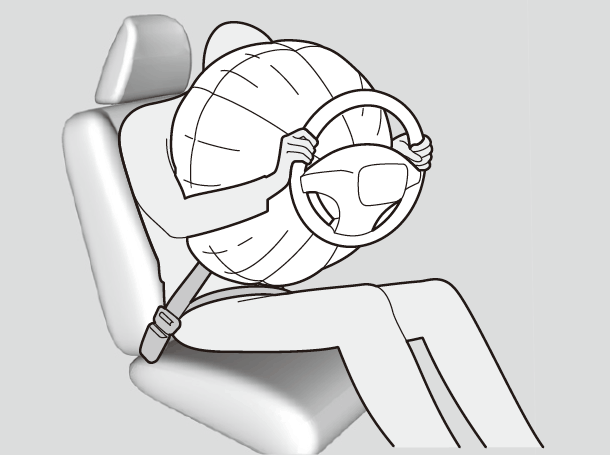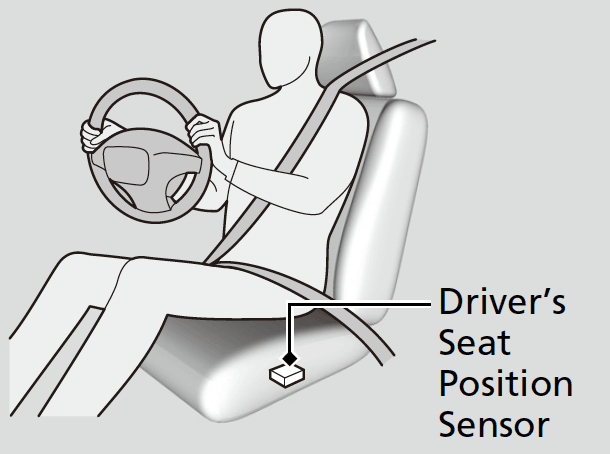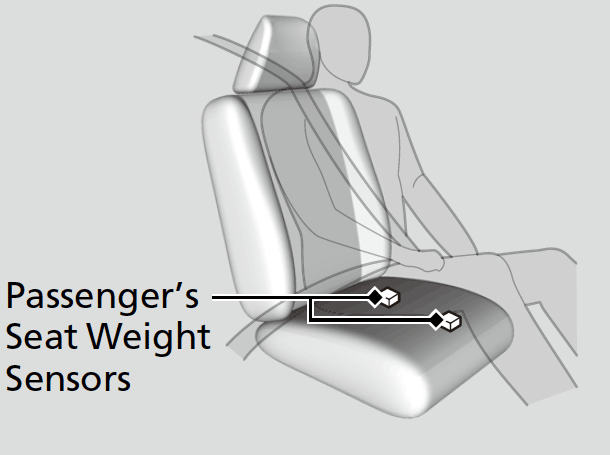Front Airbags (SRS)
The front SRS airbags inflate in a moderate-to-severe frontal collision to help protect the head and chest of the driver and/or front passenger.
SRS (Supplemental Restraint System) indicates that the airbags are designed to supplement seat belts, not replace them. Seat belts are the occupant’s primary restraint system.
- Detail
-
During a frontal crash severe enough to cause one or both front airbags to deploy, the airbags can inflate at different rates, depending on the severity of the crash, whether or not the seat belts are latched, and/or other factors. Frontal airbags are designed to supplement the seat belts to help reduce the likelihood of head and chest injuries in frontal crashes.
Housing Locations
The front airbags are housed in the center of the steering wheel for the driver, and in the dashboard for the front passenger. Both airbags are marked SRS AIRBAG.
Operation
Front airbags are designed to inflate during moderate-to-severe frontal collisions. When the vehicle decelerates suddenly, the sensors send information to the control unit which signals one or both front airbags to inflate.
A frontal collision can be either head-on or angled between two vehicles, or when a vehicle crashes into a stationary object, such as a concrete wall.
How the Front Airbags Work
-
While your seat belt restrains your torso, the front airbag provides supplemental protection for your head and chest.
The front airbags deflate immediately so that they won’t interfere with the driver’s visibility or the ability to steer or operate other controls.
-

The total time for inflation and deflation is so fast that most occupants are not aware that the airbags deployed until they see them lying in front of them.
- Detail
-
Although the driver’s and front passenger’s airbags normally inflate within a split second of each other, it is possible for only one airbag to deploy. This can happen if the severity of a collision is at the margin, or threshold, that determines whether or not the airbags will deploy. In such cases, the seat belt will provide sufficient protection, and the supplemental protection offered by the airbag would be minimal.
When front airbags should not deploy
Minor frontal crashes: Front airbags were designed to supplement seat belts and help save lives, not to prevent minor scrapes, or even broken bones that might occur during a less than moderate-to-severe frontal crash.
Side impacts: Front airbags can provide protection when a sudden deceleration causes a driver or front passenger to move toward the front of the vehicle. Side airbags and side curtain airbags have been specifically designed to help reduce the severity of injuries that can occur during a moderate-to-severe side impact which can cause the driver or passenger to move toward the side of the vehicle.
Rear impacts: Head restraints and seat belts are your best protection during a rear impact. Front airbags cannot provide any significant protection and are not designed to deploy in such collisions.
Rollovers: In a rollover, your best form of protection is a seat belt or, if your vehicle is equipped with a rollover sensor, both a seat belt and a side curtain airbag. Front airbags, however, are not designed to deploy in a rollover as they would provide little, if any, protection.
When front airbags deploy with little or no visible damage
Because the airbag system senses sudden deceleration, a strong impact to the vehicle framework or suspension might cause one or more of the airbags to deploy. Examples include running into a curb, the edge of a hole, or other low fixed object that causes a sudden deceleration in the vehicle chassis. Since the impact is underneath the vehicle, damage may not be readily apparent.
When front airbags may not deploy, even though exterior damage appears severe
Since crushable body parts absorb crash energy during an impact, the amount of visible damage does not always indicate proper airbag operation. In fact, some collisions can result in severe damage but no airbag deployment because the airbags would not have been needed or would not have provided protection even if they had deployed.
Advanced Airbags
The airbags have advanced features to help reduce the likelihood of airbag related injuries to smaller occupants.
-
The driver’s advanced airbag system includes a seat position sensor.
Based on information from this sensor and the severity of the impact, the advanced airbag system determines the optimal deployment of the driver’s airbag.
-

-
The front passenger’s advanced airbag system has weight sensors. The sensors are used for occupant classification to activate or deactivate the front passenger’s airbag.
For adult size occupants, the system will automatically activate the front passenger’s airbag. If a small adult sits in the front passenger seat and the system does not recognize him/her as an adult, see
-

We advise against allowing a child age 12 or under to ride in the front passenger’s seat. However, if you do allow a small child or infant to ride in the front passenger’s seat, the system is designed to automatically deactivate the front passenger’s airbag. Do not let a small child or infant ride in the front passenger’s seat if the airbag does not automatically deactivate.
- Detail
-
If there is a problem with the driver’s seat position sensor or the passenger’s seat weight sensors, the SRS indicator will come on, and in the event of a crash, the airbag will deploy (regardless of the driver’s seating position or passenger’s occupant classification) with a force corresponding to the severity of the impact.
For the advanced front airbags to work properly, confirm that:- The occupant is sitting in an upright position wearing the seat belt properly and the seat-back is not excessively reclined.
- The occupant is not leaning against the door or center console.
- The occupant’s feet are placed on the floor in front of them.
- There are no objects hanging from the front passenger’s seat.
- Only small, lightweight objects are in the seat-back pocket.
- The steering wheel and passenger’s side dashboard are not obstructed by any object.
- No liquid has been spilled on or under the seat.
- There is no child seat or other object pressing against the rear of the seat or seat-back.
- There is no rear passenger pushing or pulling on the back of the front passenger’s seat.
- There are no objects placed under or beside the front passenger’s seat. Improperly positioned objects can interfere with the advanced airbag sensors.
- The head restraint is not contacting the roof.
- The floor mat behind the front passenger’s seat is set in the correct position evenly on the floor. An improperly placed mat can interfere with the advanced airbag sensors.
- Recommended topic(s)

